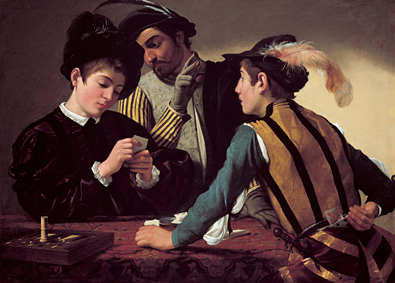Four hundred years ago, in July 1610, the painter known as Caravaggio set out on his last journey. He was travelling from Naples towards Rome in a boat loaded with three of his own paintings – gifts intended for the papal nephew, Scipione Borghese, who had helped to arrange the artist’s pardon for killing a Roman pimp named Ranuccio Tomassoni in the summer of 1606. Caravaggio had been a fugitive for more than four years, living under a banda capitale, a papal sentence of death that had been issued soon after the murder.
Now, finally, redemption was in sight. But it was not to be. Caravaggio was in a bad way even as he embarked on the felucca for Rome. Some nine months earlier he had been waylaid outside a notorious Neapolitan tavern called the Osteria del Cerriglio. Four men had attacked him in the dark alleyway next to the tavern’s side entrance. It had been a vendetta attack, payback for another of Caravaggio’s many crimes, an assault perpetrated on a nobleman on the fortress island of Malta during his long and hectically zig-zagging flight from papal justice. While three of his assailants held him down, his aggrieved Maltese enemy cut a message of revenge into Caravaggio’s face. At first, the painter had been reported dead. Later it was simply said that he had been so badly disfigured as to be almost unrecognisable. On the evidence of the two pictures that he was able to paint in the aftermath of the attack, he had been so badly injured that both his eyesight and his ability to hold a paintbrush steady had been critically compromised.
The sick man’s long-awaited journey to Rome in the summer of 1610 went badly wrong. When he got to the small coastal garrison at Palo, where...
Now, finally, redemption was in sight. But it was not to be. Caravaggio was in a bad way even as he embarked on the felucca for Rome. Some nine months earlier he had been waylaid outside a notorious Neapolitan tavern called the Osteria del Cerriglio. Four men had attacked him in the dark alleyway next to the tavern’s side entrance. It had been a vendetta attack, payback for another of Caravaggio’s many crimes, an assault perpetrated on a nobleman on the fortress island of Malta during his long and hectically zig-zagging flight from papal justice. While three of his assailants held him down, his aggrieved Maltese enemy cut a message of revenge into Caravaggio’s face. At first, the painter had been reported dead. Later it was simply said that he had been so badly disfigured as to be almost unrecognisable. On the evidence of the two pictures that he was able to paint in the aftermath of the attack, he had been so badly injured that both his eyesight and his ability to hold a paintbrush steady had been critically compromised.
The sick man’s long-awaited journey to Rome in the summer of 1610 went badly wrong. When he got to the small coastal garrison at Palo, where...


